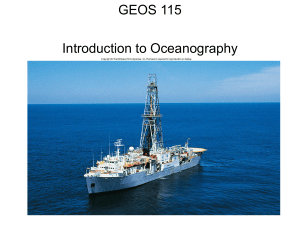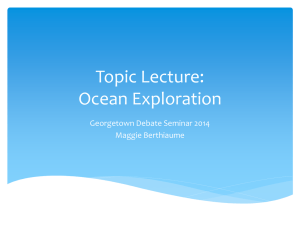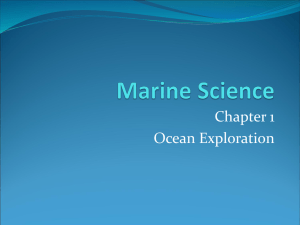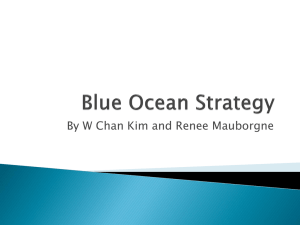Keep track of the Schedule of daily information
advertisement
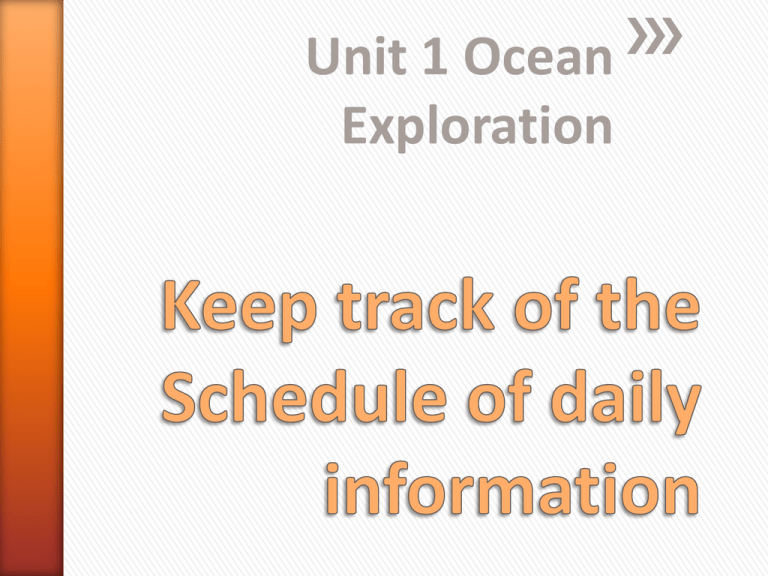
Unit 1 Ocean Exploration Welcome to Life on an Ocean Planet Sit according to Seating Chart » Objectives: Introduce the topics of oceanography Survey the text Realize the expectations of this class Review the syllabus , sign and submit acknowledgement and read and understand for syllabus quiz What do you know about the oceans? How do mariners navigate the oceans? What is the largest ocean and are they all remaining the same sizes over time? How deep are the oceans and what is the deepest part and is there anything living down there? What is the composition of ocean water and can you actually drink it? What causes ocean waves and ocean currents and does ocean water move only horizontally? Is there any connection between the oceans and our weather and climate? What causes tides and where are the largest ones? What causes tsunamis and how big can they become? How is our Puget Sound connected to the ocean? How healthy is Puget Sound and how can we determine that condition? Where do most species of living things reside in the oceans? » Text Book Survey Look over the text to get a feel for what it includes and what we will be studying Complete the Text Survey for Life on an Ocean Planet Homework: Finish the survey – due Thursday Read the syllabus to prepare for quiz tomorrow. Today’s Objectives: » Define the science of oceanography » Outline how oceanography will be studied » Relate science and technology and you » Attend to the following: Submit: Syllabus Acknowledgement Signature Earth Science: Oceans (in already?) Self Evaluation of your academic behavior and prediction of results in this class Take Syllabus Quiz Receive Unit 1 Map “Ocean Exploration” and save in your H-Drive folder, Oceanography Unit 1 Unit 1 Map Review it for: » Learning objectives » Essential questions » What you need to know » Vocabulary words You are responsible for knowing all these sections for the test 2/13/15. Unit 1 Essential Questions: » How have scientific knowledge and technological advancements been discovered and developed by various cultures and communities? » In what ways have oceanographic technologies contributed to changes in society? Answer each in bullet points ½ page each. You will be writing an essay for one of these on the Unit 1 Test » Skim Chapter 1 pages 1-3 to 1-32 » Chapter 1 Marine Science » Write the answers to the Study Questions from pages 1-3, 1-8 and 1-18 in complete sentences or write the question and phrase or single word answer and cite the page # as your source. Be sure to identify each set of questions by page number » Setup a very organized paper and clearly written paper. » Homework: Complete the Text Survey – due tomorrow (10 points formative) Chapter 1 Marine Science is due Friday, 1/30/15. Be ready for Chapter 1 Quiz on Monday, 2/2/2015 » Objectives: Submit: Teams: Relate chance to the scientific method Classify scientific reasoning Evaluate science as truth Describe the viability of a theory Evaluate social pressure and science Textbook Survey (Dyknow) Protocol, Jobs, Communication Team Work Doc in Unit 1 folder Discuss and complete and save to References folder in your H-Drive just before team assignment. What are the different areas of oceanography? (There are 4 listed in chapter 1) Biological Oceanography » Also called Marine Biology » Studies the incredible diversity of life in the ocean Chemical Oceanography » Studies the chemistry of seawater » Chemical reactions in water » Chemical changes caused by nature and humans Geological Oceanography » Studies the geography of the sea bottom and shores » Composition of sediments and rocks » Undersea volcanoes, seabed movement, earthquakes and other interactions between rock and sea Physical Oceanography » Study of physics in the Marine environment » Water movement, waves, currents, tides » How sound and light travel through water » How oceans influence weather and climate What are inductive and deductive reasoning? Inductive-proposes an explanation to explain facts/phenomena you observe Deductive-propose what you would observe if a known process were to occur » Inductive Reasoning Example: Scenario: 1.Enter room, smell smoke & sulfur, no fire 2. Previous experience suggests: Someone lighted a match » Deductive Reasoning Example: Scenario: 1. Someone is about to light a match 2. Past experience suggests: If the match is lighted, there will be a smell of smoke & sulfur Inductive Reasoning : Previous experience and end result suggests an action that did occur. Deductive Reasoning: Previous experience and observation of an action suggests an end result. If I feel the temperature drop and see an increase in clouds, I predict it will snow. What kind of reasoning is that? Team Work: Scientific Method Sidebars –due today 1-22 Chance, Serendipity, Discovery 1-24 Science, Philosophy, and Search for Truth 1-29 Hypothesis, Theory, and Critical Thinking 1-32 Science and Social Pressure Each member choose a Sidebar and read carefully Summarize each with the guiding questions Each member share out and reader/writer compile on to one document. (document – S-Drive or hardcopy) » Submit the one document and distribute to the other team members to save in their H-Drive, Unit 1 Ocean Exploration folder. » You are responsible for knowing the answers to each of the guiding questions » » » » » » » » **Return to Chapter 1 Entry 1 Study Questions** » Study Questions from pages 1-3, 1-8 and 1-18 » Skim through Ch. 1 to answer » Answer in complete sentences and save in your folder for Oceanography Unit 1 Checked in as on time tomorrow and CCS over the weekend Chapter 1 Quiz on Monday! Objectives: Explain how knowledge of history, use of archeology and skill in technology leads to recovery of high-value shipwrecks Check off: Chapter 1 Marine Science Study Questions Homework: Check, Correct and Score this entry by going to Nash Swift Site Video Prompt Summary Monday: Chapter 1 Quiz based on your work so far » Focus: » Video: » Class Work: » Submit: When is history important? Treasure Quest: Pirates Treasure Quest: Pirates Video Prompt in Oceanography folder & save to your Unit 1 Ocean Exploration folder Prompt and Summary (on Monday) − Include 5 knowledge/skills in each category − Note the number of times INDUCTIVE & DEDUCTIVE REASONING are used to solve the mysteries. on Amazon Video Do you have Prime?? » Objectives: Demonstrate your knowledge of the science of oceanography Focus: Check & Submit: CCS & Submit: How is oceanography a science? Complete: Quiz: Treasure Quest: Pirates Chapter 1 Study Questions Scientific Method Sidebars Are You Learning? Chapter 1 Marine Science Submit: Chapter 1 Study Questions CCS (Checked, Corrected and Scored – 5 points) Be sure that you have shown by symbol or added answer in a different font the CC & write the number missed at the top of your paper Check & Submit: Scientific Method Sidebar Highlight your correct responses and add to your responses from the key (do this to all answers) » Are You Learning? ˃ Indicate the page ˃ Cover the Check it Out with a sticky note ˃ Answer the multiple choice ˃ Uncover Check it Out and score your responses ˃ Do this for all 3 sections: 1-7. 1-17, 1-33 ˃ Submit the paper Take the Chapter 1 Quiz Objectives: Investigate the history and technology of oceanography Focus: How has the science of oceanography been developed and why? Chapter 2 History of Ocean Exploration and Marine Sciences » Steps today: *Endless Voyage: First Steps *Chapter 2 History of Ocean Exploration & Marine Sciences *Study Questions: 2-3, 2-4, 2-16, 2-19, 2-23 & 2-33 Breakdown of work: Today, Tomorrow, Thursday 30 points: Complete – 20, Sentences – 5, CCS – 5 (i.e. D if all 43 questions are answered) -Due Friday for check in and then CCS over the weekend » Objectives: Focus: Outline the progress through history of cultural interactions with the oceans Create a timeline How did various cultural groups the world over interact with the oceans and contribute to our understanding? Study Questions: Where are you on the schedule? Directions for the Project: o Work as a team o Divide up the work for the culture/assignment/project “Ocean Exploration Timeline” Flow Map via Power Point or Prezi o Use mainly the text and enhance with outside reference for other information and graphics. o Decide what format your team will use and what and your design and display options o Print the name of the creator of the slide at the bottom corner in smaller font size. o Formative is 25 points total: 15 team and 10 individual o Summative is 10 points individual o Be ready for a Gallery Walk Objectives: Create a timeline of the progress of cultures through history to use and understanding of our oceans Work as individual and coordinate with your team to develop the timeline via power point slides Identify oceanography vocabulary terms Discuss the development of marine sciences via the individual scientists Steps: -Complete your panel/slide for your culture(s) -Begin assembling team flow chart for Ocean Exploration Timeline -Write “bullet points” to the first Essential Question -Chapter 2 Study Questions due tomorrow -Monday: Review, Analyze and Evaluate the Ocean Exploration Timelines via Gallery Walk » » » » » Chapter 1 Marine Science Quiz Results not so good Quiz Corrections on Friday during class Write the complete sentence answers for each one missed Add back ½ the points you missed, i.e. 12/20 becomes 16/20 Could not access the video Treasure Quest: Pirates? Go to Odyssey Quest Marine (shortcut in S-Drive Outbox Oceanography folder) and access “Shipwrecks” Read about them, particularly the Black Swan Complete the Treasure Quest assignment & submit on Monday, 2/9 Chapter 2 Study Questions due tomorrow Objectives: Complete a timeline of the progress of cultures through history to use and understanding of our oceans Review the science of oceanography Complete Timeline Submit Chapter 2 Study Questions Correct Chapter 1 Quiz Homework: Check (+ or other symbol next to each answer that is correct), Correct (different color and font) , and Score (-missed) Ocean Exploration Timeline » Individuals place your name in small font lower corner of your slide and finalize (RER) » Collector/Assembler finalize the project and place it in the S-Drive (GB) » Everyone highlight your culture(s), then…… » check √ off all the 6 parts that you addressed. If you did a part that was not in the book place a star * next to it. Correct Chapter 1 Quiz » Write the complete sentence answers for all the questions you missed. » Cite the page that supports your answer from the textbook » Attach your corrections on top of the scantron and submit » You will get ½ points missed added back. » Objectives: Determine the contributions of various cultures and individuals to the advancement oceanography Review the terminology Submit: Ocean Exploration Timelines (Inbox period folder) Evaluate: Ocean Exploration Timeline projects & gather information from them (due today) Vocabulary: CCS: Crossword Chapter 2 Study Questions both due tomorrow Word list: » Technology » Science » Situatedness » Culture » Remotely operated vehicle » Loran » Theory » Bathyscaphe » Bathysphere » Archaeology » Hypothesis » Submersible » Wayfinding » Autonomous underwater vehicle Objectives: Focus on the aspects of navigation that allow Polynesians to travel thousands of miles across the ocean Summarize the techniques Submit: Crossword to tray and CCS of C-2 Questions Dyknow Focus: What is necessary to navigate the oceans without the aid of present day technology? » Review the prompt for “Light at the Edge of the World: The Wayfinders” » Watch the video Most important parts: up to 22 minutes and then 35 minutes to the end at 46 minutes » Complete the notes » Both found in the S-Drive Outbox Oceanography Hardcopy up front » Write the summary on the back » Submit tomorrow Objectives: Review your knowledge of the history of oceanography Evaluate the wayfinding trip Model sonar and map the ocean bottom for a channel Review: What was so special about the wayfinders and the Polynesian sailors? Submit: Wayfinders What can we do today that does not require their methods of navigation? Why was the Hokolae important? Focus: How is the floor of the ocean mapped? How was it originally mapped? What is echolocation and sonar? How do satellites measure depth? Submit: Light at the Edge of the World: Wayfinders Today: Ocean Mapping (Gizmo) *Go to Swift Website for link to Gizmo and go to the site *Enroll in the Class. Copy and paste the class code sent to you via Dyknow *Open the Gizmo and Exploration Sheet *Save Exploration & Maps to your H-Drive *When completed, place in S-Drive Ocean Mapping for your period as one continuous document. *Complete the Assessment Homework: Are You Learning? 2-3, 2-15, 2-19, 2-22, 2-32, 2-47 Write the letter answers with Check it Out covered. Correct and score. Due tomorrow Homework: Are You Learning? For Chapter 2 Tomorrow: Chapter 2 Oceanography History Quiz Take Home Modern Technology Timeline Friday: Dive to the Bottom of the Ocean Challenger Deep in the Marianas Trench After President’s Week Vacation Monday: Review for Unit 1 Test Tuesday: Unit 1 Test Don’t stop and get ready to go until 2:08 Objectives: Demonstrate your knowledge of the history of Oceanography and Marine Science Map the Timeline of Marine Technology Review: What is used to specify a location on the ocean bottom? What makes it possible to locate the changes in depth? Schedule: 1. Submit the “Are You Learning?” to Tray or Inbox 2. Complete the Marine Technology Timeline pages 2-33 to 2-46 check & submit 3. Take Home the Chapter 2 Quiz – submit tomorrow Done? Ocean Mapping gizmo Include both the Exploration Sheet & the two maps on one document Submit to the S-Drive Inbox your period Marine Technology Timeline due Friday Objectives: Describe the techniques and technology used to explore the Mariana Trench Compare and contrast the 4 expeditions Focus: Could you imagine yourself under several miles of water? What would you see? Submit: Chapter 2 Quiz Marine Technology Timeline Is your Gizmo for Ocean Mapping in my S-Drive folder for your period? Due After Break: Dive to the Bottom of the World Review your Grades: Over break and submit outstanding work by Monday, February 23 Tuesday 2/24: Unit 1 Test In S-Drive Outbox View: Dive to the Bottom Complete: Video Prompt Summary: Compare and contrast all 4 dives Objectives: Review science and history and exploration techniques of oceanography for the unit 1 test. Submit: Dive to the Bottom of the World video prompt All other unit work for late credit (avoid ZAP) Study: Unit 1 Ocean Exploration Study Guide & verify complete Essential Question: Write bullet points on 3x5 card for essay part of test Homework: CCS Unit 1 Study Guide w/Key Tomorrow: Unit 1 Test (35 points for MC & EQ) Choose either of the following two Essential Questions and prepare a thoughtful, well-organized, and well-written essay. (10 points total) Option #1: “How have advancements in scientific knowledge and technology been discovered and developed by various cultures and communities? (chapter 1) Option #2: “In what ways have oceanographic technologies contributed to changes in society?” (chapter 2) Select actual examples and specific reasons, details, and facts in support of your thesis. Such examples could be drawn from the text and/or class materials/assignments Your work will be evaluated on the following criteria: (3 points) Clarity of writing: How well do your thesis, supporting reasons, facts, and details communicate your ideas? (2 point) Proper use of conventions: spelling, grammar, punctuation (2 points) Organization of essay (introduction, body, conclusion) (3 points) Accuracy of information presented
